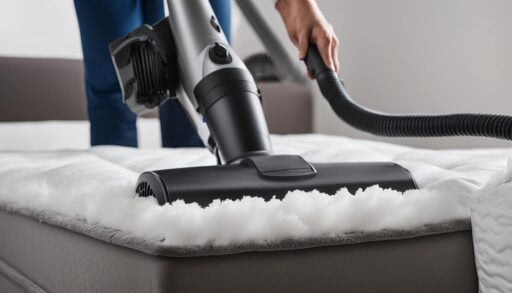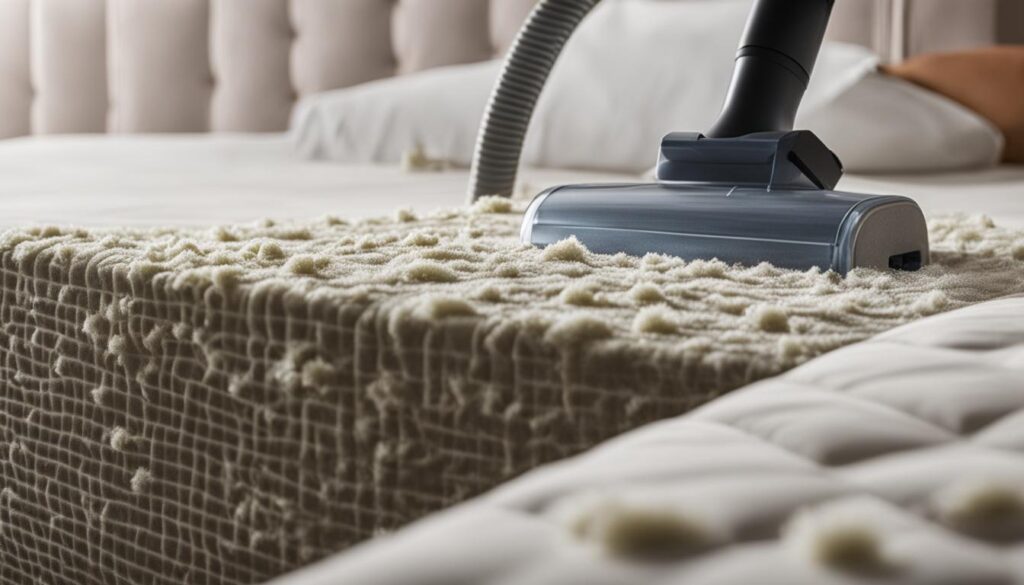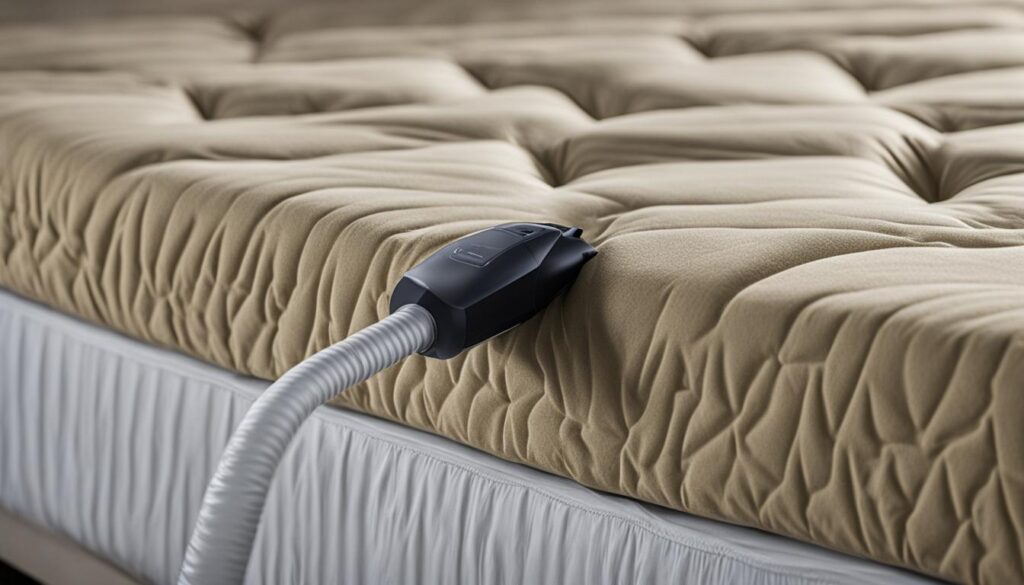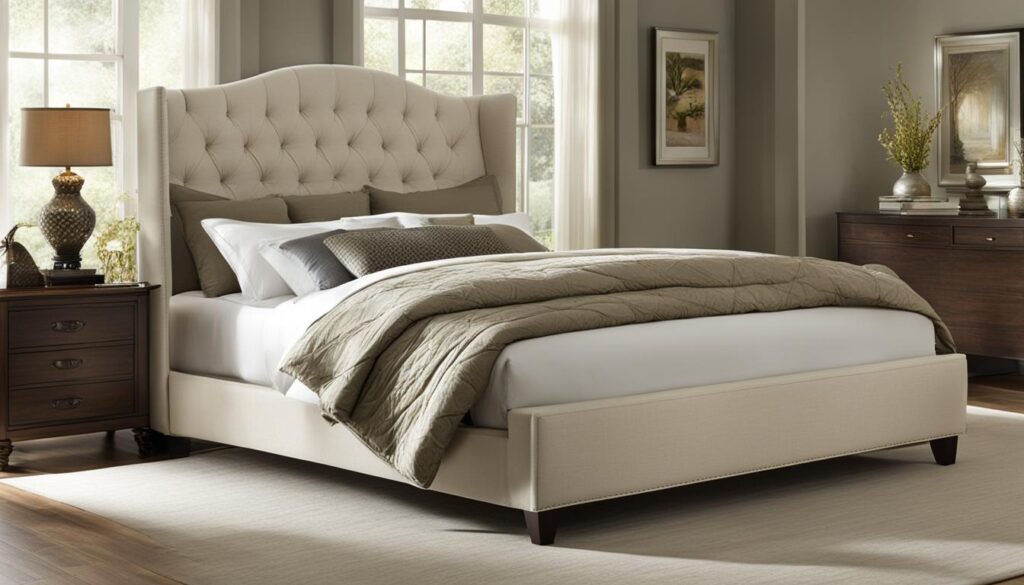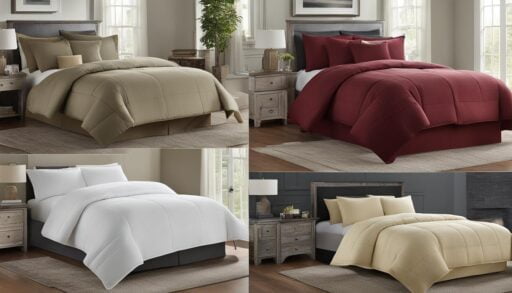Cleaning your mattress regularly is essential for maintaining a clean and hygienic sleeping environment. While there are many commercial cleaning products available, using baking soda and vinegar is a natural and effective method for deep cleaning and freshening your mattress. In this article, we will guide you through the process of cleaning your mattress with these common household ingredients.
Key Takeaways:
- Using baking soda and vinegar is a natural and cost-effective way to clean and freshen your mattress.
- This DIY cleaning method is effective for stain removal and odor elimination.
- Identify the type of mattress you have before using baking soda and vinegar to ensure compatibility.
- Regularly clean and maintain your mattress to extend its lifespan and promote better sleep hygiene.
- Consider using a mattress protector to prevent spills and stains and make cleaning easier.
Determine the Type of Mattress You Have
Before diving into the mattress cleaning process with baking soda and vinegar, it’s essential to determine the type of mattress you have. Different mattress types require different cleaning approaches to ensure their longevity and safety. Understanding your mattress type will help you take the necessary precautions and achieve the best results.
Here are some common mattress types:
- Foam Mattress
- Latex Mattress
- Hybrid Mattress
- Regular Mattress
While cleaning your mattress with baking soda and vinegar is generally safe for most mattress types, it’s crucial to exercise caution when dealing with foam and hybrid mattresses. These types of mattresses may not dry as efficiently, so it’s essential to ensure proper ventilation and moisture removal during the cleaning process. Regular mattresses, on the other hand, are typically more resilient to moisture and can withstand the cleaning method more effectively.
Furthermore, it’s important to consider the specific safety guidelines provided by the mattress manufacturer. Some mattresses may have specific cleaning instructions or require professional cleaning. Always refer to the manufacturer’s recommendations to avoid any potential damage to your mattress.
Foam Mattress
| Pros: | Cons: |
|---|---|
| – Contouring support | – May retain moisture |
| – Good motion isolation | – Takes longer to dry |
| – Pressure relief | – Requires extra caution during cleaning |
Latex Mattress
| Pros: | Cons: |
|---|---|
| – Natural and eco-friendly | – May absorb moisture |
| – Good durability | – May take longer to dry |
| – Hypoallergenic | – Requires extra caution during cleaning |
Hybrid Mattress
| Pros: | Cons: |
|---|---|
| – Combination of support and comfort | – May retain moisture |
| – Suitable for various sleep preferences | – Takes longer to dry |
| – Enhanced breathability | – Requires extra caution during cleaning |
Regular Mattress
Regular mattresses, which can include innerspring or pocket coil mattresses, are generally more resilient to moisture and can handle the baking soda and vinegar cleaning method with less risk. However, it’s still important to follow the proper cleaning steps and ensure thorough drying to maintain the mattress’s overall integrity and prevent any potential damage.
Clean Under the Bed
While cleaning your mattress, don’t forget to clean under the bed as well. Dead skin cells, pet hair, and dust can accumulate in this area, affecting the overall cleanliness and hygiene of your sleeping environment. Regularly vacuuming under the bed helps remove these contaminants, ensuring a cleaner sleeping space. It’s also important to note that if you have pets, their dander may contribute to the buildup under the bed.
Table: Contaminants Found Under the Bed
| Contaminant | Description |
|---|---|
| Dead skin cells | Shed from our bodies, these skin cells can accumulate and attract dust mites. |
| Pet hair | Hairs shed by pets can be easily trapped under the bed and contribute to allergies and asthma symptoms. |
| Dust | Common household dust consisting of various particles, including dirt, pollen, and allergens. |
| Dander | Small flakes of skin and saliva that animals produce, which can cause allergic reactions. |
By regularly cleaning under the bed, you can minimize the presence of these contaminants and promote a healthier sleeping environment. Be thorough when vacuuming, ensuring that you reach all corners and crevices. Consider using a vacuum cleaner with a HEPA filter to effectively capture and remove allergens.
Additionally, if you have a bed frame with slats or a platform bed, make sure to clean these areas as well. Dust and debris can accumulate between the slats or underneath the platform, so use a vacuum attachment or a long-handled duster to reach these spaces.
Consider Using a Mattress Protector
Protecting your mattress is an essential part of mattress maintenance. A mattress protector acts as a barrier against spills, pet accidents, and stains, ensuring that your mattress stays clean and fresh for longer. It’s a simple and effective way to safeguard your investment and prolong the lifespan of your mattress.
When accidents happen, a mattress protector can provide the necessary spill protection, preventing liquids from seeping into the mattress and causing potential damage. Whether it’s a spilled drink, a pet accident, or even sweat, a mattress protector creates a protective layer that can be easily cleaned or replaced.
“A mattress protector can be a lifesaver when it comes to maintaining the cleanliness of your mattress. It adds an extra layer of defense against spills, stains, and accidents, making it easier to keep your mattress fresh and hygienic.”
When it’s time to clean your mattress protector, most options are conveniently machine-washable. Simply remove the protector from your mattress and follow the manufacturer’s instructions for washing. For added freshness, you can soak the protector in a hot water and vinegar solution before washing to remove any odors or stains. It’s a quick and easy process that helps keep your mattress protector in top condition.
Table: Comparison of Different Mattress Protector Options
| Feature | Basic Mattress Protector | Waterproof Mattress Protector | Hypoallergenic Mattress Protector |
|---|---|---|---|
| Spill Protection | ✓ | ✓ | ✓ |
| Allergen Protection | ✓ | ||
| Machine-Washable | ✓ | ✓ | ✓ |
| Temperature Regulation | ✓ |
Table: Comparison of Different Mattress Protector Options
When choosing a mattress protector, consider your specific needs and preferences. A basic mattress protector provides spill protection and is easy to clean, making it suitable for most individuals. If you’re looking for additional benefits, such as waterproofing or hypoallergenic properties, there are specialized options available in the market. Evaluate the features that are most important to you and select a mattress protector that aligns with your requirements.
A mattress protector is a smart investment for maintaining the cleanliness and longevity of your mattress.
Evaluate the Age of Your Mattress
Assessing the age of your mattress is crucial for ensuring quality sleep and overall health. A mattress’s lifespan can vary depending on factors such as mattress quality, sleep quality, and mattress durability. It is generally recommended to replace your mattress every 6 to 8 years, but this timeline can differ based on individual usage and wear and tear.
An old mattress can negatively impact your body and sleep comfort, leading to aches, pains, and restless nights. Over time, mattresses can lose their firmness and supportive structure, causing discomfort and disrupting your sleep. By regularly evaluating the age of your mattress, you can make an informed decision about when it’s time to invest in a new one.
When considering mattress replacement, it’s important to prioritize both your sleep quality and overall well-being. A worn-out mattress may no longer meet your comfort needs or provide adequate support for your body. By upgrading to a new mattress, you can experience improved comfort, spinal alignment, and a better night’s sleep.
| Benefits of Evaluating Your Mattress Age: |
|---|
| Quality Sleep: A new mattress can improve sleep quality, allowing you to wake up feeling refreshed and rejuvenated. |
| Total Comfort: Upgrading to a newer mattress can provide better support, relieving pressure points and reducing discomfort. |
| Enhanced Durability: Investing in a quality mattress ensures its longevity, meaning you can enjoy years of restful sleep. |
By regularly evaluating the age of your mattress and considering the benefits of mattress replacement, you can prioritize your sleep health and create a more comfortable sleeping environment.
Rotate or Flip Your Mattress Regularly
To maintain the shape and durability of your mattress, it is recommended to regularly rotate or flip it. This practice helps distribute the wear and tear, preventing sagging in specific areas. However, it’s important to note that not all mattresses allow for rotation or flipping.
For traditional mattresses without a pillow top or a remote-controlled bed feature, flipping the mattress every few months can provide even usage of the surface. This means that the side that was previously at the head of the bed will now be at the foot, and vice versa. In addition to flipping, rotating the mattress 180 degrees can also help ensure equal wear.
However, if you have a pillow top mattress or a bed with a remote control mechanism, rotating or flipping the mattress may not be possible or recommended. These types of mattresses are designed with specific comfort layers or features that should not be altered. Check the manufacturer’s guidelines to determine the best care approach for your specific mattress.
By incorporating regular rotation or flipping into your mattress care routine, you can extend its lifespan and maintain a comfortable sleep surface for years to come.
Benefits of Baking Soda and Vinegar for Mattress Cleaning
If you’re looking for a non-toxic and natural way to clean your mattress, baking soda and vinegar are two powerful ingredients that can deliver impressive results. These household staples offer several benefits for mattress cleaning, ensuring a cleaner and healthier sleeping environment.
Benefits of Baking Soda for Mattress Cleaning
Baking soda acts as a natural deodorizer, effectively absorbing moisture, odors, and dirt from your mattress. Its fine particles penetrate deep into the fabric, neutralizing unpleasant smells caused by sweat, spilled liquids, and general everyday use. Baking soda also helps to eliminate dust mites, allergens, and dead skin cells, leaving your mattress fresh and revitalized.
To use baking soda for mattress cleaning, simply sprinkle a generous amount over the entire surface and let it sit for several hours to allow the baking soda to absorb odors and moisture. Vacuum the mattress thoroughly to remove the baking soda residue along with any trapped dirt particles, leaving your mattress clean and odor-free.
Benefits of Vinegar for Mattress Cleaning
Vinegar is a powerful natural cleaning agent that offers multiple benefits for mattress cleaning. Its acidic properties make it highly effective in killing bacteria, germs, and mold spores. Vinegar also helps to neutralize strong odors and can remove stains caused by sweat, urine, or spills.
To use vinegar for mattress cleaning, dilute it with water in a spray bottle and lightly mist the entire surface of the mattress. Allow the vinegar solution to sit for a few hours to break down stains and eliminate odors. Afterward, blot the mattress with a clean cloth to absorb any excess liquid. Let the mattress air dry completely before putting on fresh bedding.

By harnessing the power of baking soda and vinegar, you can effectively clean your mattress without using harsh chemicals. These natural ingredients not only remove stains and odors but also promote a healthier sleeping environment by eliminating allergens and bacteria. Incorporate baking soda and vinegar into your mattress cleaning routine for a refreshing and non-toxic cleaning solution.
Gather the Necessary Materials
Before starting the mattress cleaning process, it’s important to gather all the necessary materials. Having these supplies on hand will ensure that you can clean your mattress effectively and efficiently.
Mattress Cleaning Supplies
To clean your mattress with baking soda and vinegar, you will need the following:
- Baking soda: This versatile ingredient helps absorb moisture and eliminate odors.
- Vinegar: Vinegar is known for its antibacterial properties and is effective at neutralizing odors.
- Spray bottle: Use a spray bottle to evenly distribute the vinegar solution on the mattress surface.
- Sifter: A sifter can be used to evenly sprinkle baking soda on the mattress.
- Vacuum cleaner: A vacuum cleaner will help remove baking soda, dirt, and debris from the mattress.
By having these supplies ready, you can easily follow the step-by-step guide for cleaning your mattress with baking soda and vinegar. Remember, using natural ingredients like baking soda and vinegar can be a safer and more eco-friendly option for mattress cleaning.
Now that you have all the necessary materials, you can proceed to the next section and learn the step-by-step process to clean your mattress with baking soda and vinegar.
Step-by-Step Guide on How to Clean a Mattress with Baking Soda and Vinegar
Follow these simple steps to effectively clean your mattress using baking soda and vinegar:
- Remove all bedding: Start by stripping the mattress of all bedding, including sheets, pillowcases, and mattress protectors. These will need to be washed separately.
- Apply the vinegar solution: Fill a spray bottle with equal parts vinegar and water. Lightly mist the entire surface of the mattress with the solution. Vinegar is known for its antibacterial properties, helping to eliminate odors and sanitize the mattress.
- Distribute baking soda: After spraying the vinegar solution, use a sifter to evenly distribute a generous layer of baking soda over the mattress surface. Baking soda acts as a natural deodorizer and helps absorb moisture and dirt.
- Let it sit: Allow the baking soda and vinegar solution to sit on the mattress for a few hours, or even overnight if possible. This will give the ingredients enough time to work their magic and break down stains and odors.
- Vacuum the mattress: Using a vacuum cleaner with an upholstery attachment, thoroughly vacuum the entire mattress surface. This will remove the baking soda, along with any dirt, dust, or debris that may have been absorbed.
- Let the mattress dry: Finally, allow the mattress to air dry completely before making the bed. It’s important to ensure that the mattress is fully dry to prevent the growth of mold or mildew.

By following these steps, you can effectively clean your mattress using baking soda and vinegar, leaving it fresh, sanitized, and free of stains and odors.
Professional Mattress Cleaning Services
If you prefer not to clean your mattress yourself or if you don’t have the time, professional mattress cleaning services are available. Many cleaning companies offer mattress cleaning as part of their services, along with carpet cleaning. Consider hiring professionals to ensure a thorough and convenient cleaning process. Research local companies in your area to find reliable and reputable options.
“Professional mattress cleaning services can save you time and effort while ensuring a deep and effective clean for your mattress. With their expertise and specialized equipment, these companies can remove stubborn stains, eliminate odors, and prolong the lifespan of your mattress. By investing in professional cleaning, you can enjoy a cleaner and healthier sleeping environment.”
Benefits of Professional Mattress Cleaning Services:
- Expertise: Professional cleaners have the knowledge and experience to handle different types of mattresses and address specific cleaning needs.
- Advanced Equipment: Cleaning companies use specialized equipment and techniques to achieve deep cleaning and better results compared to DIY methods.
- Stain Removal: Professionals have access to powerful stain removal products and techniques to tackle even the toughest stains on your mattress.
- Odor Elimination: With their professional-grade cleaning solutions, mattress cleaning companies can effectively eliminate unpleasant odors, leaving your mattress smelling fresh and clean.
- Convenience: Hiring professionals allows you to sit back and relax while they take care of the entire cleaning process, saving you time and effort.
When choosing a mattress cleaning company, make sure to read reviews and check their credentials. Look for companies that use eco-friendly and non-toxic cleaning products to ensure the safety of you and your family. Prioritize companies that offer satisfaction guarantees and provide transparent pricing. With professional mattress cleaning services, you can rest easy knowing your mattress is in good hands.
| Company | Services Offered | Rating |
|---|---|---|
| ABC Cleaning | Mattress cleaning, carpet cleaning | 4.5/5 |
| Sparkling Clean | Mattress cleaning, upholstery cleaning | 4/5 |
| Fresh Sleep Solutions | Mattress cleaning, stain removal | 4.8/5 |
Pro Tips for Effective Mattress Cleaning
When it comes to cleaning your mattress with baking soda and vinegar, there are a few pro tips that can help you achieve the best results. First, make sure to pre-clean your mattress by removing all bedding and vacuuming thoroughly. This will help remove any surface dirt and debris before you begin the deep cleaning process.
Before applying the vinegar solution, perform a patch test in an inconspicuous area of your mattress to ensure that it won’t cause any discoloration or damage. This is especially important if you have a sensitive or delicate mattress material.
When applying the vinegar solution, be careful not to over-wet the mattress. While vinegar is an effective cleaner, excess moisture can be detrimental to your mattress and may lead to mold or mildew growth. A light spray is usually sufficient to achieve the desired cleaning effect.
After applying the vinegar solution, don’t rush to vacuum up the baking soda. Let it sit on the mattress for several hours, or even overnight, to allow it to absorb moisture and odors thoroughly. This will maximize its effectiveness and leave your mattress feeling fresh and clean.
To ensure complete mattress drying, it’s essential to give it ample time to air out. Avoid placing bedding back on the mattress until it is completely dry to prevent any potential mold or mildew growth. You can expedite the drying process by opening windows, using fans, or even placing the mattress in a well-ventilated area.
By following these pro tips, you can effectively clean your mattress with baking soda and vinegar, ensuring a fresh and healthy sleeping environment.
Conclusion
Cleaning your mattress with baking soda and vinegar is a cost-effective, natural, and efficient method for maintaining a clean and fresh sleeping surface. By following the simple steps outlined in this article, you can easily remove stains, eliminate odors, and freshen up your mattress using common household ingredients.
Remember to regularly clean and maintain your mattress to promote better sleep hygiene and extend its lifespan. Vacuuming under the bed to remove dead skin cells, pet hair, and dust is an important step in ensuring a cleaner sleeping environment. Additionally, consider using a mattress protector to prevent potential damage from spills and accidents.
By assessing the age of your mattress and rotating or flipping it regularly, you can distribute wear and prevent sagging, maintaining its shape and prolonging its lifespan. Baking soda and vinegar offer numerous benefits for mattress cleaning, acting as natural deodorizers and bacteria killers without the use of harsh chemicals.
With these simple steps and tips, you can enjoy a cleaner and more comfortable sleeping environment, ensuring that your mattress remains fresh, hygienic, and supportive for years to come.
FAQ
How often should I clean my mattress with baking soda and vinegar?
It is recommended to clean your mattress with baking soda and vinegar every few months or as needed. Regular maintenance helps keep your mattress fresh and free from stains and odors.
Can I use this cleaning method on all types of mattresses?
While baking soda and vinegar cleaning is generally safe for most mattresses, it’s important to exercise caution with foam and hybrid mattresses, as they may not dry as efficiently. Regular mattresses are typically more resilient to moisture. Consider the safety precautions for cleaning your specific mattress type.
How do I clean under the bed?
To clean under your bed, regularly vacuum the area to remove dead skin cells, pet hair, and dust. This helps maintain the overall cleanliness and hygiene of your sleeping environment.
Why should I use a mattress protector?
A mattress protector acts as a barrier against spills, accidents, and stains, making it easier to maintain the cleanliness of your mattress. It’s recommended to soak it in a hot water and vinegar solution before washing it to remove any odors or stains.
How often should I replace my mattress?
It is generally recommended to replace your mattress every 6 to 8 years, depending on the type and level of wear and tear. An old mattress can negatively impact your body and sleep comfort, so investing in a new one when needed is essential for optimal rest.
Can I flip or rotate all mattress types?
While regular mattresses can be rotated or flipped to distribute wear and prevent sagging, certain mattress types such as pillow top mattresses or remote-controlled beds may not allow for this. If your mattress allows for rotation or flipping, consider doing so to maintain its shape and prolong its lifespan.
What are the benefits of using baking soda and vinegar for mattress cleaning?
Baking soda acts as a natural deodorizer, absorbing moisture and odors while eliminating dirt, dust, sweat, and dead skin cells. Vinegar kills bacteria and odors effectively. When combined, these ingredients create a powerful and non-toxic solution for cleaning your mattress.
What materials do I need to clean my mattress with baking soda and vinegar?
To clean your mattress with baking soda and vinegar, you will need baking soda, vinegar, a spray bottle, a sifter, and a vacuum cleaner. These items will help you effectively clean and freshen your mattress.
What is the step-by-step process for cleaning a mattress with baking soda and vinegar?
First, remove all bedding and wash it separately. Then, spray a light coating of vinegar over the entire mattress and let it sit for a few hours. Next, use a sifter to distribute baking soda evenly on the mattress surface and let it sit for a few more hours. Vacuum the mattress thoroughly to remove the baking soda and any remaining dirt or debris. Finally, let the mattress air dry completely before putting the bedding back on.
Can I hire professionals to clean my mattress?
Yes, if you prefer not to clean your mattress yourself or if you don’t have the time, professional mattress cleaning services are available. Many cleaning companies offer mattress cleaning as part of their services, along with carpet cleaning. Research local companies in your area to find reliable and reputable options.
How can I optimize my mattress cleaning process?
To optimize your mattress cleaning, pre-clean your mattress by removing all bedding and vacuuming thoroughly. Perform a patch test with the cleaning solution in an inconspicuous area to ensure compatibility with your mattress. Avoid over-wetting the mattress while applying the vinegar solution. Let the baking soda sit on the mattress for an extended period to maximize its odor and moisture-absorbing properties. Finally, ensure complete drying of the mattress before placing the bedding back on to prevent mold and mildew growth.
What are the benefits of cleaning my mattress with baking soda and vinegar?
Cleaning your mattress with baking soda and vinegar is a cost-effective, natural, and efficient method for maintaining a clean and fresh sleeping surface. It helps remove stains, eliminate odors, and freshen up your mattress. Regular cleaning also promotes better sleep hygiene and extends the lifespan of your mattress.




